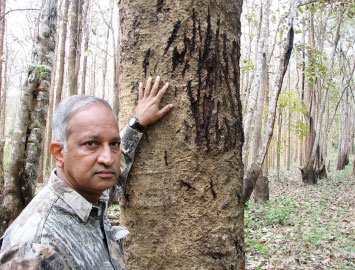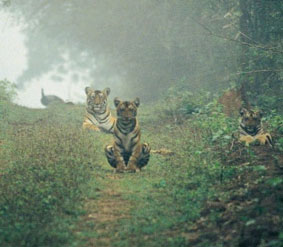Hope remains for India's wild tigers, says noted tiger expert
As 2010 marks “The Year of the Tiger” in many Asian cultures, there has been global interest in the long-term viability of tiger populations in the wilds of Asia. Due to increasing pressures on remaining tiger habitats and a surge in demand for tiger parts from traditional medicine trades, many conservation experts consider the current outlook for wild tiger populations bleak. Dr Ullas Karanth of the Wildlife Conservation Society (WCS) India does not share this view. He believes that a collaboration of global and local interests can secure a future for tigers in the wild.
The following is a field update from Dr Karanth.
AN INTERVIEW WITH ULLAS KARANTH
Mongabay: Dr Karanth, what is your outlook in regard to global tiger conservation in 2010, "The Year of the Tiger?"
Dr Ullas Karanth: That is a rather sweeping question! Some folks had predicted an increased pressure from the “parts trade” due to cultural reasons related to "The Year of the Tiger." I am not sure if that prediction is being borne out (a strong and ironic upswing in tiger poaching for the parts trade). However, given that many Asian countries are experiencing continued economic growth, both positives and negative impacts of such growth on wild tigers are bound to increase.
I am reasonably sure that in the Karnataka State of South West India where we work with a number of local partner NGOs, the prospect for wild tigers is quite positive: tiger densities are high and holding steady in Nagarahole and Bandipur reserves and increasing in the Bhadra reserve. It all depends on sustaining our positive momentum, but I am not in total despair like many other tiger conservationists appear to be on the issue of long-term viability of wild tigers.
Mongabay: Could you tell our readers briefly about WCS’s current work with the Bengal tiger in the wilds of India?
Dr Ullas Karanth: WCS has worked since 1988 with Indian tigers (I prefer that name to the archaic "Bengal tiger"). This started in the Nagarahole reserve and we have expanded the scope of this project to a 25,000 square kilometer area known as the Malenad-Mysore Tiger Landscape (MMTL) that encompasses and connects several adjacent tiger reserves. WCS staff works closely with local partners, both NGOs and government groups, to develop this program. At the core of this work is the research and monitoring program encompassing this conservation area, implemented by partners like the Centre for Wildlife Studies and National Centre for Biological Sciences. The results of this research and monitoring are then turned into “policy prescriptions” or direct conservation action by working closely with other partners including the National Tiger Conservation Authority. This collaborative work focuses on enhanced protection for tigers, their prey and environment, through habitat consolidation and de-fragmentation of tiger areas through the active promotion of voluntary, incentive-driven relocation of human settlements out of core tiger habitats harboring “source” or core tiger populations. It is public outreach and local education, however, which are the key elements in all of this work. There is room in India (and the rest of Asia) for people and wild tigers. We are working with local peoples to foster the understanding that healthy forests (ecosystems) populated with wild animals, including tigers, sustains the health of the broader environment, including the areas of human habitation. The effectiveness of this public outreach and the sustained management of “source habitats” and the real time monitoring of tiger numbers and their prey species in these management areas is what ultimately tells us whether we are succeeding or failing in our efforts. This approach seems to be working.
Mongabay: "Project Tiger," the Indian Government's national tiger conservation project, is close to the 40-year anniversary of the program's inception in 1972. The project has had limited success. How do you feel about the prospects of the Indian Government's new focus on the project? Is the Indian Government taking the right steps?
Dr Ullas Karanth: I feel good that the national government and some state governments are indeed showing increased commitment in terms of providing funds for tiger conservation. However, the actions they implement are not always guided by best practices in either tiger science or conservation. Sometimes too much money spent unwisely can become a big problem. Partnering with “on the ground NGOs” and working with the local communities is key to the viability of these projects.
Mongabay: What steps do you feel will need to be taken on a global basis to ensure that wild tiger populations are sustained by 2022 the next "Year of the Tiger." Please also discuss your thoughts on upcoming projects like the “Global Tiger Summit” in St Petersburg, Russia.
Dr Ullas Karanth: WCS scientists and several other conservation groups recently emphasized a prescription or blueprint for the recovery of wild tiger populations. We know 70% of the remaining source tiger populations that offer some hope of recovery are now concentrated on just 6% of remaining tiger habitat. And these critical core habitats are where we have to prevent killing of tigers and prey, rather than wring our hands in despair after tigers are poached. If focus is brought back to on-ground protection, habitat consolidation and intensive real-time monitoring for these source, core tiger populations, tigers can rebound, reach saturation densities, and then repopulate wider landscapes (a fact we have documented in Karnataka, India). On the other hand, if conservationists get distracted by an array of omnibus approaches that take on every problem identified (and imaginable), and act in a dissipated manner, we will continue to lose the remaining tiger source populations. There is now broad global interest in saving wild tigers and most of these various groups and interests mean well. But I do not find much evidence of the clear, focused thinking that is needed in upcoming projects like the “Global Tiger Summit in Russia,” so I do not have great hopes from what I have seen so far these types of efforts. But it is good that these types of projects are fostering an opportunity for dialog and collaboration. Tiger conservation communities and interests need to use these opportunities to “get on the same page” and develop practical, field tested strategies if this global goodwill is going to have any long-term merit.
It is all about learning from past mistakes and adopting best practices. In the final analysis, the only reliable metric of success (or failure) should be recovery of tiger numbers, not money spent, goodwill generated (etc.), which are really just tools in a conservationist's kit.
The following is a field update from Dr Karanth.
AN INTERVIEW WITH ULLAS KARANTH
Mongabay: Dr Karanth, what is your outlook in regard to global tiger conservation in 2010, "The Year of the Tiger?"
 Dr Karanth in "Tiger Country" with evidence of Local Tigers Photo courtesy of WCS India and Dr Ullas Karanth. |
I am reasonably sure that in the Karnataka State of South West India where we work with a number of local partner NGOs, the prospect for wild tigers is quite positive: tiger densities are high and holding steady in Nagarahole and Bandipur reserves and increasing in the Bhadra reserve. It all depends on sustaining our positive momentum, but I am not in total despair like many other tiger conservationists appear to be on the issue of long-term viability of wild tigers.
Mongabay: Could you tell our readers briefly about WCS’s current work with the Bengal tiger in the wilds of India?
 Indian tiger. Photo courtesy of WCS India and Dr Ullas Karanth. |
Mongabay: "Project Tiger," the Indian Government's national tiger conservation project, is close to the 40-year anniversary of the program's inception in 1972. The project has had limited success. How do you feel about the prospects of the Indian Government's new focus on the project? Is the Indian Government taking the right steps?
Dr Ullas Karanth: I feel good that the national government and some state governments are indeed showing increased commitment in terms of providing funds for tiger conservation. However, the actions they implement are not always guided by best practices in either tiger science or conservation. Sometimes too much money spent unwisely can become a big problem. Partnering with “on the ground NGOs” and working with the local communities is key to the viability of these projects.
Mongabay: What steps do you feel will need to be taken on a global basis to ensure that wild tiger populations are sustained by 2022 the next "Year of the Tiger." Please also discuss your thoughts on upcoming projects like the “Global Tiger Summit” in St Petersburg, Russia.
 Top Predators Like Tigers are a Vital Part of a Healthy Forest Ecosystem and Environment Photo Courtesy of WCS India and Dr Ullas Karanth. |
It is all about learning from past mistakes and adopting best practices. In the final analysis, the only reliable metric of success (or failure) should be recovery of tiger numbers, not money spent, goodwill generated (etc.), which are really just tools in a conservationist's kit.
Subscribe to:
Post Comments (Atom)
save

Site Archive
-
▼
2010
(107)
-
▼
October
(31)
- WWF: Saving tigers should be the concern of all
- Poacher shot dead in Rajaji Park
- U.S. urged to regulate 'backyard tigers'
- Russian tiger summit offers 'last chance' to save ...
- Adopt a tiger @ 15,000
- R’than govt nod for mining near Sariska tiger reserve
- Mining threat looms over Sariska tigers
- NTCA panel to visit Bander project on Friday
- Maneater on the prowl, mauls 3 in Mathura
- Wildlife board bats for big cats
- Bengal sceptical about canal project passing throu...
- "Jhurjhura tigress" dies revealing government apathy
- Did poachers get another tiger?
- Illegal mining threatens Sariska
- Camera catches bulldozer destroying Sumatra tiger ...
- Confusion over count of tigers on prowl as pug mar...
- Ranthambore tiger 'Mohan' wrecks havoc in Mathura
- Campaign in Goa: Buy a cow, save the tiger
- Arunachal to constitute special tiger protection f...
- Two held with tiger's body parts
- Marching orders for humans in tiger territory
- 4-year-old tigress Minchu is latest to die at BBP
- Tiger found dead in MP's Kanha reserve
- Arrested poachers killed over 100 tigers
- Even human skin will be traded some day: Supreme C...
- Tiger cubs yet to be traced in Panna sanctuary
- Veerappan land now a Tiger den
- Two tiger cubs spotted in Ranthambore
- Evidence of tiger presence in Goa: Official
- Experts baffled by 'small' Bangladesh tigers
- Hope remains for India's wild tigers, says noted t...
-
▼
October
(31)
Search on net
Popular Posts
-
Not only is tiger a beautiful animal but it is also the indicator of the forest's health. Saving the tiger ...
-
Tiger sightings have become quite rare these days in India, reason being the Tiger killings because of its multitude of medicinal or magical...
-
Over the past century the number of tigers in India has fallen from about 40,000 to less than 4,000 (and possibly as few as 1,500). Relentle...
-
At the turn of the 20th century, according to estimates, India probably had many thousand tigers in the wild. In 2002, based on a census u...
-
The Tiger Reserves in India is one of the projects undertaken by the wildlife lovers to protect the Indian tigers. The Tiger Reserves of I...
Tiger

Tiger

Contact me
For Feedback and queries or any suggestions contact me at:
manikarpan19@gmail.com
or
www.facebook.com/arpanjotsingh
manikarpan19@gmail.com
or
www.facebook.com/arpanjotsingh







0 comments:
Post a Comment